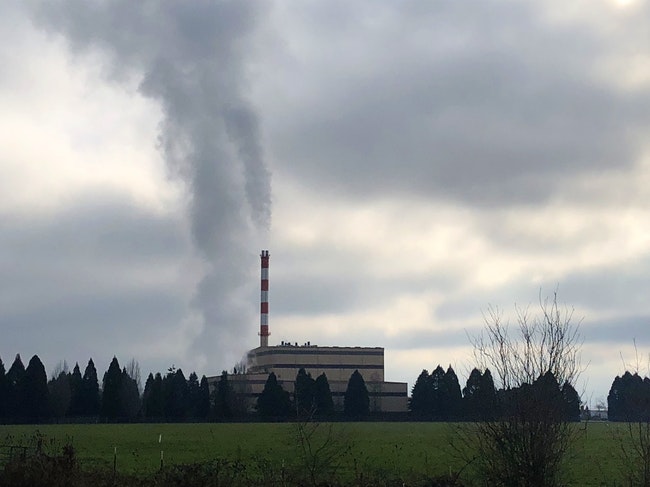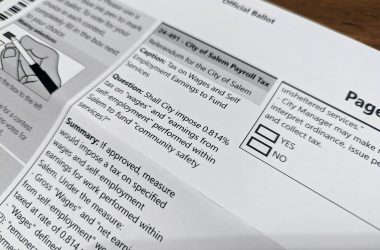In the eight years Sen. Deb Patterson served at the Smyrna United Church of Christ in Canby, 30 of her fellow members died, many of rare forms of cancer.
The Salem Democrat said the deaths made her wonder about environmental causes of illness — like the Covanta Marion garbage burner located 18 miles southwest of the church in Brooks.
Patterson said she can’t tie the facility’s emissions to any of the deaths, but the experience prompted her to push for a bill requiring more frequent emissions monitoring and sampling for the facility.
“We have to know what’s in the air we’re breathing,” she told Salem Reporter.
Senate Bill 488 passed the Senate and House in the final days of the 2023 legislative session and now awaits Gov. Tina Kotek’s signature.
The bill is intended to provide Oregon’s environmental regulator, the Department of Environmental Quality, more continuous information about environmental impacts of the state’s large trash incinerator.
The facility would be required to report a plan to the DEQ of how it will monitor levels of 15 compounds over a year, including carbon monoxide, sulfur dioxide, lead and mercury.
The bill would require that the facility make emissions data available to the public. It is still allowed to burn no more than 18,000 tons of hospital, medical or infectious waste per year, the limit already set in its existing contract with Marion County.
Covanta, a New Jersey-based waste management company, has operated in Marion County since 1987 and burns garbage to generate energy as an alternative to sending trash to a landfill.
Covanta Marion processes about 90% of the county’s garbage, according to the county’s website. The rest – consisting of construction and demolition waste, food processing waste and non-burnable materials – go to the county’s demolition landfill in Salem or a landfill outside the county.
Commissioners voted in June 2021 to approve a three-year contract with Covanta Marion as the previous contract expired.
Haulers are required to take garbage to the Brooks facility. It is classified as a garbage incinerator but also burns industrial and medical waste from out of state and Canada, according to reporting from the Statesman Journal.
Medical waste – which includes syringes, gloves, and medical tubing – has a higher percentage of plastic than household waste, and the types of plastics they contain emit more toxic compounds when burned, Patterson said in March 7 testimony supporting the bill.
Covanta Marion will now be required to submit its plan for a year of monitoring emissions to the Department of Environmental Quality within three months after the law takes effect in late September.
The state agency in February 2022 fined Covanta $15,700 for an air quality violation.
Testimony for the bill was overwhelmingly in favor, with support from anti-pollution and environmental groups. Covanta and the Marion County Board of Commissioners opposed the bill.
Lloyd Naideck, Covanta’s director of government relations, testified in March that the company has emitted well below the federal government’s limit.
He also said that regulated medical waste is a cleaner waste stream than household waste.
Naideck said the state DEQ is in the middle of implementing Cleaner Air Oregon, an effort Gov. Kate Brown started in 2016 to clean up air pollution through reviewing emissions and health risks.
“Until they make public their analysis and determination, any facts or science being presented is not from a regulator,” he said in an email to Salem Reporter.
Regarding how the bill will impact Covanta’s costs and operations, he said, “As we don’t have an accepted plan from DEQ yet, we cannot give an estimate.”
The Marion County Board of Commissioners also opposed the bill in written testimony.
“Over 99.9 percent of what comes out of our Covanta’s Marion Facility stack is what would typically be found in the air: water vapor, nitrogen, oxygen, and carbon dioxide,” the board wrote. “The remaining constituents are well below federal and state standards.”
The facility is about a half-mile from Chemeketa Community College’s Brooks campus as well as Willamette Valley Christian School.
Patterson said the bill is also intended to reduce the environmental impacts on people living in Brooks and north Salem, many of whom are people of color or lower-income residents. The incinerator sits in the 97305 ZIP code, which is about 43% Latino and has a 19% poverty rate, higher than Salem and Oregon, according to 2021 Census data.
“They just have less power to address the issues that are surrounding them. They’re busy working, taking care of their families,” she said.
Contact reporter Ardeshir Tabrizian: [email protected] or 503-929-3053.
SUPPORT OUR WORK – We depend on subscribers for resources to report on Salem with care and depth, fairness and accuracy. Subscribe today to get our daily newsletters and more. Click I want to subscribe!

Ardeshir Tabrizian has covered criminal justice and housing for Salem Reporter since September 2021. As an Oregon native, his award-winning watchdog journalism has traversed the state. He has done reporting for The Oregonian, Eugene Weekly and Malheur Enterprise.









